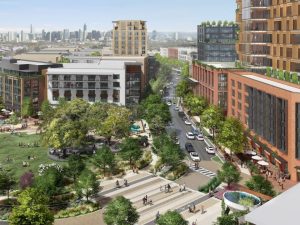$1B Austin Mall Makeover Gets Key Approval
An aging retail center is being transformed into an office and residential complex.

Rendering of the Brodie Oaks shopping center redevelopment in southwest Austin, Texas. Image courtesy of Barshop & Oles Co.
The Austin City Council has approved a planned unit development rezoning that will allow developers Barshop & Oles and Lionstone Investments to proceed with their $1 billion redevelopment of the Brodie Oaks shopping center in southwest Austin, Urbanize reported.
The under-used retail complex, at South Lamar Boulevard and South Capital of Texas Highway/Loop 360, was originally built in the 1980s. The redevelopment will create a 37.6-acre mixed-use district tentatively encompassing nearly 1.3 million square feet of office space, 1,700 residential units, restaurants, retail space and possibly a 200-key hotel, along with 13.7 acres of open space. Plans call for nine buildings up to 25 stories in height.
The redevelopment plan had to overcome community opposition regarding building heights and environmental impacts. In response and in addition to the green space, the design was modified to slash the existing amount of impervious cover.
The project has been in process for at least four years. The city council’s approval reportedly means that work on the final designs and the first phase of permitting could start by next year. Construction on the first phase could start in 2025 and wrap up by 2027, while overall completion of the entire redevelopment might take up to 10 years.
READ ALSO: Discount Grocers Stocking CRE Opportunity
Besides Barshop & Oles and Lionstone, the redevelopment team includes Overland Partners (architecture), DPZ Codesign (urban planning), Nelsen/Nygaard (transportation planners), BOE (transportation consultants), Speck and Associates (design), Armbrust and Brown (legal), and LJA Engineering.
Slow for a while
The approximately 10-year time frame for building out the Brodie Oaks redevelopment might be a good thing, given the current state of Austin’s office market. The ongoing expansion of sublease vacancy is a factor in pushing overall vacancy to 21.3 percent, an increase of 70 basis points just since the first quarter, according to a second-quarter report from CBRE.
On the positive side, new construction is slow; just one building, of about 33,000 square feet, was completed in the second quarter. Further, CBRE reports, “Austin continued to lead the top metros in the nation in return-to-work efforts,” with an average building occupancy rate of 58.2 percent in late June, according to Kastle Systems.






You must be logged in to post a comment.